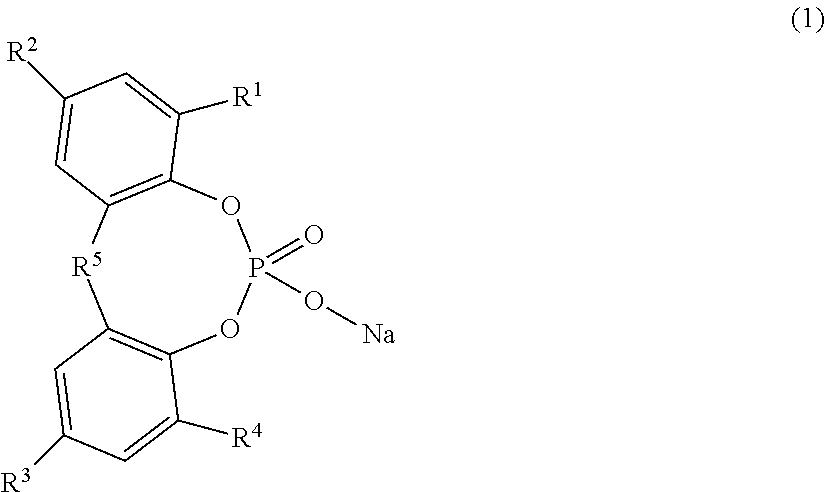Resin additive composition, thermoplastic resin composition, and molded article thereof
- Summary
- Abstract
- Description
- Claims
- Application Information
AI Technical Summary
Benefits of technology
Problems solved by technology
Method used
Image
Examples
examples
[0271]Hereinafter, the present invention will be described more specifically with reference to Examples, but the present invention is not limited to the following Examples and the like in any way.
(Preparation of Resin Additive Composition)
examples 1-1 to 1-6
and Comparative Examples 1-1 to 1-3
[0272]A resin additive composition of a phosphoric acid ester compound (A) represented by the general formula (1) and a fatty acid sodium (B) represented by the general formula (2) was prepared at the ratios shown in Table 1. The unit of the blending amount in the Table is parts by mass. For each of the obtained compositions, measurement of angle of repose and evaluation of adhesion were carried out according to the following procedure.
(1) Angle of Repose
[0273]The resin additive composition described in Table 1 was placed in a cylindrical container (500 mL) so as to have a volume of half of that of the cylindrical container, a lid was closed, and the fluidity of a sample was evaluated by rotating at a constant speed of 2.0 rpm using a repose angle measuring instrument (Revolving Cylinder Test) manufactured by TSUTSUI SCIENTIFIC INSTRUMENTS CO., LTD. As the cylindrical container rotates, the sample is lifted along the rotating container, and the sam...
examples 2-1 to 2-4
and Comparative Examples 2-1 to 2-5
(Evaluation of Resin Composition)
[0276]0.05 parts by mass of a phenolic antioxidant (tetrakis[methylene-3-(3′,5′-di-tert-butyl-4′-hydroxyphenyl)propionate]methane), 0.1 parts by mass of a phosphorus antioxidant (tris(2,4-di-tert-butylphenyl)phosphite), 0.05 parts by mass of calcium stearate, and the resin additive composition shown in Tables 2 and 3 were blended with 100 parts by mass of homopolypropylene (product name “H700” manufactured by Prime Polymer Co., Ltd., melt flow rate=8.0 g / 10 min (2.16 kg×230° C. according to ISO standard 1133)), mixed with 1,000 rpm×1 minute by a Henschel mixer, and then, using a twin-screw extruder, the mixture was kneaded under conditions of extrusion temperature=230° C., screw rotation speed=150 rpm, and feed rate=7.2 kg / h to prepare a pellet. The unit of the blending amount in the Table is parts by mass. The obtained resin composition was evaluated by the following method. The obtained results are shown in Tables...
PUM
| Property | Measurement | Unit |
|---|---|---|
| Percent by mass | aaaaa | aaaaa |
| Percent by mass | aaaaa | aaaaa |
| Percent by mass | aaaaa | aaaaa |
Abstract
Description
Claims
Application Information
 Login to View More
Login to View More - R&D
- Intellectual Property
- Life Sciences
- Materials
- Tech Scout
- Unparalleled Data Quality
- Higher Quality Content
- 60% Fewer Hallucinations
Browse by: Latest US Patents, China's latest patents, Technical Efficacy Thesaurus, Application Domain, Technology Topic, Popular Technical Reports.
© 2025 PatSnap. All rights reserved.Legal|Privacy policy|Modern Slavery Act Transparency Statement|Sitemap|About US| Contact US: help@patsnap.com



